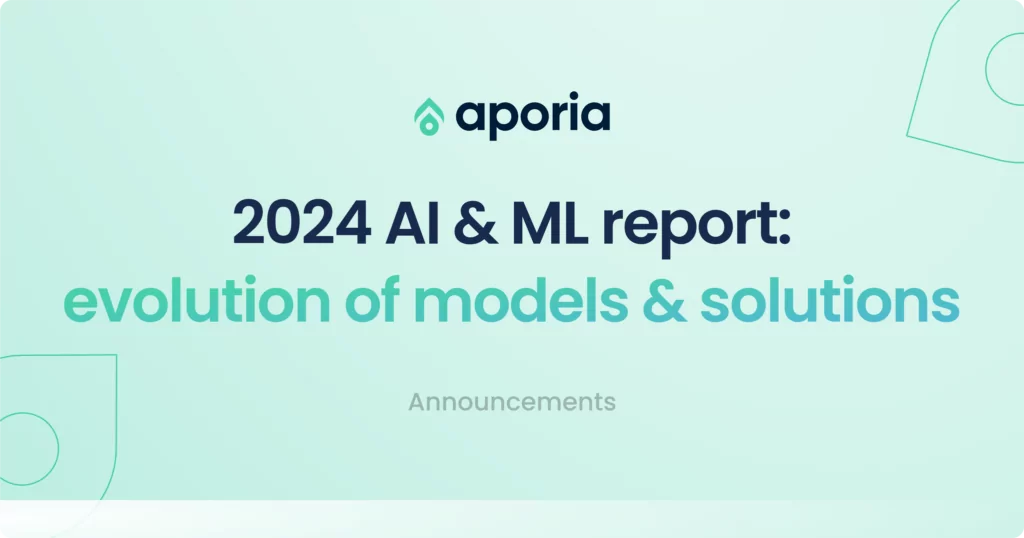
The Journey to AI Control: Embracing the Future with Aporia
As we step into a new era at Aporia, I’m thrilled to share the story behind our transition from being...
You’ve probably heard about the hallucinations AI can experience and the potential risks they introduce when left unchecked. From Amazon’s job recruiting models filtering out female candidates to Microsoft’s chatbots turning rogue on Twitter – the perils are real. But you know what? We can (and should) do better. So, let’s talk about Responsible AI (RAI), what it means, how it can help combat the pitfalls of AI, why it’s vital for every AI leader, and how you can actually make it work for your organization.
Responsible AI (RAI) refers to the designing, building, deploying, and production management of AI workflows and systems in a manner that is ethical, transparent, compliant, and aligned with societal values and norms. It ensures that AI products are developed with a human-centric approach and are accountable for the decisions they make. A critical challenge in this realm, however, lies with a phenomenon known as AI hallucinations.
What are AI Hallucinations?
AI hallucinations are instances where AI systems perceive patterns or connections that do not truly exist, often leading to errors or inaccuracies in the output. These false perceptions can pose a significant setback for RAI practices as they can lead to unintended or harmful decisions. They can also compromise the transparency and fairness of the AI, considering they might result in actions that are difficult to explain, potentially biased, or not aligned with the system’s intended purpose. It’s important to address AI hallucinations and implement essential safeguards and monitoring tools to foster a responsible AI culture that ensures AI products behave as intended.
In the broader picture, RAI practices must consider a wide range of issues including fairness, transparency, explainability, privacy, security, compliance, and ensuring that AI systems do not perpetuate biases or have unintended harmful consequences. Remember, you’re not just building models; you’re creating an impact. That’s why addressing challenges like hallucinations and keeping that impact transparent, accountable, and ethical is non-negotiable. In doing so, you can truly leverage the power of AI while minimizing potential risks and setbacks.
Too many times AI leaders are either flying blind or lose sight of how their AI will operate in the wild. The blockers currently holding back the full might of your AI products boil down to a lack of transparency and accountability, unintended biases, regulations, and data protection laws. And not to forget, you might also face the wrath of the public and lose trust if your AI acts up.
When it comes to hands-on solutions, there’s a noticeable gap in the availability of a universal framework on how to actually bring Responsible AI to life. In this article, you’re going to get a solid, no-nonsense blueprint that you can take straight to your team, making sure your AI not only boosts business but also does good for people around.
The road to RAI is bumpy. Finding biases in massive datasets? It’s like finding a needle in a haystack. And trying to explain complex models in simple terms? That may keep you up at night. After defining the main problem with implementing RAI, let’s break down the challenges organizations face when attempting to roll out an AI product.
Challenge: Collecting unbiased data is easier said than done. Many datasets have historical biases built into them, and once these models interact with the real world even more unintentional biases perpetuate discriminatory decisions. For instance, facial recognition technologies have been known to have biased datasets that underrepresent certain ethnic groups.
Risks: If AI systems are left unmonitored, these biases continue to impact your AI’s decision-making process. This can lead to bad PR and the alienation of certain groups, or even legal actions against your company for discrimination.
Challenge: AI models, especially deep learning, can be like black boxes – even the developers sometimes don’t know why the AI made a certain decision.
Risks: Lack of transparency can cause distrust among users. In critical applications like healthcare or finance, this lack of transparency can have serious consequences, such as misdiagnosis or unfair loan denials. In the US, financial institutions and banks are required by law to provide explanations when denying someone a loan.
Challenge: AI systems often require massive amounts of data, which may include sensitive information. Ensuring that data is handled securely and in compliance with regulations is not trivial.
Risks: Data breaches can result in the loss of sensitive information, damaging both individuals and the company’s reputation. Additionally, non-compliance with data protection regulations can result in hefty fines and legal complications.
4. Governance
Challenge: Setting up robust governance structures for overseeing the development and deployment of AI systems is a complicated task. While numerous organizations have presented AI governance frameworks, like the Ethics Guidelines for Trustworthy AI by the EU, the Australian AI Ethics Framework, and OECD AI Principles, the lightning-speed advancement of AI can often outpace these governance mechanisms. Establishing a comprehensive framework that consistently assesses fairness, interpretability, and ethics of AI systems is critical.
Risks: Absence or ineffective AI governance can lead to misalignment with ethical standards and regulatory norms, raising trust issues with stakeholders. Unchecked development and use of AI systems might inadvertently lead to harmful consequences and could damage the reputation of the organization. Moreover, inadequate governance might fail to prevent biased decision-making, unfair practices, or potential misuse of AI, resulting in legal repercussions and societal harm.
Challenge: Establishing clear lines of accountability for AI decisions can be complicated, especially in systems where human input and AI output are both factors in decision-making.
Risks: Without clear accountability, it’s difficult to establish who or what is responsible when something goes wrong. This can lead to public relations disasters and potentially expensive legal battles.
Challenge: AI systems operate in a rapidly evolving regulatory environment. Staying compliant with all the relevant laws and regulations requires vigilance and adaptability.
Risks: Non-compliance can lead to legal penalties, loss of licenses, and damage to reputation. It can also result in the need to make expensive changes to AI systems to bring them into compliance.
Challenge: As AI systems grow, so does their complexity. Ensuring that AI systems can scale without losing performance or accuracy is challenging.
Risks: Failure to properly scale an AI system can lead to system crashes or degraded performance. This can lead to financial losses and a decline in customer trust.
It’s inevitable, your AI will hallucinate and make mistakes, making it even more important to have watchdog guardrails in place to ensure your AI is making inclusive, transparent, and correct decisions. Who’s got your back when your AI goes rogue? That’s where accountability comes in. It’s about taking responsibility for the AI’s decisions and making its workings transparent and understandable to all (or at least to those who built the model). Your team, and when relevant your customers, should know how and why your AI made a specific call.
Your AI needs to play fair. This means ensuring it doesn’t favor one group over another. That Amazon recruiting algorithm we talked about earlier? Yeah, that’s what we need to avoid. It’s about mitigating biases in training datasets and monitoring real world data coming in so that your AI doesn’t discriminate.
No one wants a legal nightmare. Ensuring your AI complies with data protection and privacy laws is crucial. Plus, you gotta keep the data secure because risking customer data is a fast track to losing trust and hurting your bottom line.
After discussing the challenges and laying the groundwork for RAI, now let’s get down to practice. The ongoing discussion around the importance of RAI has been insightful, but with organizations releasing new AI products every day, ML teams and stakeholders need a practical framework they can lean on to ensure they steer clear of the risks and dangers mentioned above.
Having a centralized dashboard that empowers the entire organization to monitor AI products in production, keep track of their predictions, and ensure they make fair and unbiased decisions while enabling swift investigation and remediation if things go sideways.
Because AI is unpredictable and can face countless unique edge cases, organizations need to set up alerts for any out-of-the-ordinary predictions based on what they understand and definitively know about their model. This also means that organizations must continuously monitor their AI products in production to ensure consistent performance, address evolving user needs, and mitigate new risks.
It’s crucial to routinely assess your models’ performance alongside key stakeholders, including product managers, data scientists, and engineers, concentrating on evaluating metrics, pinpointing issues, and delegating action items and owners to enhance performance. Communication between stakeholders here is key to help identify where the model is under/over-performing.
Know exactly who jumps into action when alerts are fired and define a clear workflow for your first responders on handling different scenarios for both short-term fixes (response) and long-term solutions (remediation). A decision tree is best practice here, as it defines the exact roles, owners, and responsibilities for when your AI is acting up.
Additionally, setting up fallback systems can save you headaches and a lot of time – such as reverting to a previous version of your model or switching on a non-ML-based algorithm or heuristics that were used before deploying the ML model. The final step here is to investigate the root cause, summarize it, log it, and learn from it to improve response in the future.
For a more practical and detailed dive into Responsible AI, read our ebook here ???? “The Good AI: A Responsible AI Roadmap”
There you have it. Implementing Responsible AI is no small feat, but it’s worth the sweat. The big picture? It’s not just about the cool models and the nifty predictions. It’s about the impact your AI will have on the real world and its users. Keep it transparent, accountable, and fair. Stay up-to-date on regulatory compliance. Communicate and review. Tackle incidents with a plan. Build AI that’s not just productive but also responsible.
Want to learn more about tackling the problem of AI Hallucinations? How to practice responsible AI in your organization? Feel free to reach out to us, we’re happy to help.

As we step into a new era at Aporia, I’m thrilled to share the story behind our transition from being...

In the ever-evolving field of AI, the maturity of production applications is a sign of progress. The industry is witnessing...

In the first installation of our guide to building great AI products, we discussed the challenges of deploying models to...